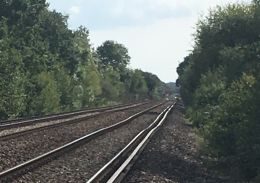Posted 27th September 2018 | 3 Comments
Controversial lineside tree felling set to continue

Distorted track in Sussex
TREE felling alongside railways is set to continue, in spite of loudly-voiced protests from environmentalists and naturalists. Network Rail has warned that the problems caused by lineside trees are becoming worse because of the exceptionally dry weather this year in south east England.
The company has come under fire for clearing trees and other vegetation in a bid to reduce the annual problems caused by ‘leaves on the line’, which are sometimes treated as a joke but can be a major cause of delays in the months running up to Christmas.
Engineers are particularly hard at work in south east England, which experienced the hottest summer on record this year and also has the busiest commuter lines in the country. The prolonged drought means the ground is the driest it has been since soil moisture levels began to be recorded almost two decades ago, with pothole-like defects preventing some trains from running at normal line speeds in Kent and Sussex.
It means some journey times have been extended by a few minutes in localised areas, but with the long-range weather forecast predicting more dry weather, there is a risk of more speed restrictions to come.
Tree-felling, meanwhile, is also continuing, in spite of the protests.
Network Rail’s route asset manager for the south east is Derek Butcher, who is a geotechnics engineering expert.
He said: ‘The Met Office declared this year’s summer the joint hottest on record with only half the average rainfall in the south east.
‘Therefore, it’s not just gardeners bemoaning this incredibly dry weather. Network Rail staff in Kent and Sussex are working around the clock to ensure millions of passengers in the region can travel safely.
‘Many railway embankments in the region are made of clay and almost all of them are populated by trees and other vegetation. So during long periods of hot weather without rain, deciduous trees can suck moisture from the ground faster than it can be replenished.
‘This causes the ground under the track to shrink and much like potholes on the roads, trains can’t drive at full speed over these defects. We’re doing everything we can to stay on top of these problems and stop the risk of increasing journey times.
‘But with the long range forecast predicting more dry weather, we are braced and ready for more issues.’
Network Rail said it has spent almost £300,000 in Kent and Sussex tackling the issue over the past nine weeks and is now increasing resources even further. Engineers have used 3,000 tonnes of ballast so far in the south east to reinforce embankments over 15km of track, and £283,000 has been spent repairing defects caused by the drought. In some areas, and only where it is absolutely necessary. Network Rail is now warning that it will need to clear what are considered the thirstiest trees and vegetation to remove the risk of further damage to the railway.
Derek added: ‘We would need three months’ worth of rain to fall in a month for ground water levels to return to normal, which based on current forecasts is highly unlikely in the short term.’
Reader Comments:
Views expressed in submitted comments are that of the author, and not necessarily shared by Railnews.

John Gilbert, Cradley
Simply to echo the remarks of Peter McGivern and Jim Livesey. The only reason trees are growing on embankments and in cuttings these days is because British Rail 'economised' by not keeping them cut back to nothing - as always done in the past. So there is really nothing for tree preservationists to gripe about; the trees are only there because the railway authorities have not been doing their job!! Thank goodness they, the Railways, are now getting their act together!! (NB And I am a member of the Woodland Trust!)
Peter McGivern, Brackley
I look forward to seeing large scale lineside tree felling throughout the UK. Far too many 'self-set' and unmanaged trees on embankments, cuttings and damaging bridges and viaducts. On some journeys it is like travelling in a gloomy corridor - such are the long stretches of tree infested lineside.
Jim Livesey, Mirfield
More power to your elbow Network Rail. Unfortunately this work is long overdue. BR did not tackle vegetation very much following the replacement of "linesmen" with mobile gangs from the sixties onwards. I remember travelling to Brighton in the early days of Thameslink and being shocked at how little I could see of any countryside south of the London suburbs.
NR are using contractors to do the chopping...the contract specifies how far from the lineside vegetation should be removed/cut back. It does not seem to be far enough to eliminate leaf fall to the rails and as to passengers having a view...forget it!